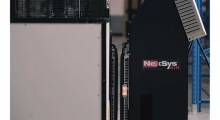With annual e-retail distribution volume accelerating at a rate of 25 percent according to eMarketer, many distribution center operations have taken significant steps in making the transition to more automated, digital processes to keep pace with the unrelenting e-commerce fulfillment speeds and order volumes. However, many of these companies have reached a tipping point, one where the fulfillment strategies of the past simply can’t keep pace with the demands of modern commerce now and into the future.
Today, automation alone is simply not enough. Even with the improvements that the move to digital has brought, many operations continue to strain under the weight of modern e-commerce complexities, rising customer service expectations and labor availability challenges. After all, slim margins and fierce competition leave no room for error, and the race to improve never ends. And as many distribution center operators have found, simply adding more workers or more shifts is not a viable long-term strategy. Especially, since the warehouse sector has an estimated 40 percent annual employee turnover rate according to the Bureau of Labor Statistics. To stay competitive, retailers and distribution centers need to continue their journey to digital transformation and better connect their assets, people and processes to address modern commerce challenges.
Enabling connectivity in the distribution center can uncover opportunities to greatly improve fulfillment operations, and in the process, dramatically increase revenue. A connected distribution center can continuously monitor activities occurring in all fulfillment systems and processes and notify operators when issues arise, targets are not met or errors are made, so that they can make the necessary real-time adjustments and allocate resources more efficiently. Most importantly, building a connected workforce that’s more productive, more accurate and more flexible to changing demands can have a significant and positive impact on operations, boost performance and reduce costs. This is critical as distribution centers are struggling today with finding, training and retaining qualified employees, so supporting them with the right tools can improve employee satisfaction and ultimately productivity.
Today, there is technology available to provide the holistic and connected approach that businesses need today to stay competitive and enable their digital transformation. From advanced scanning solutions and connected mobile devices, to voice-directed technology, workflow automation tools, robotics solutions and software, these tools, when connected, can gather important data to help businesses make more informed decisions, automate processes, guide workers through their tasks to ultimately help them work faster, smarter and more efficiently to improve operations, while keeping them safer.
Most importantly, such connected solutions are not only available to large, complex distribution centers. Smaller to medium-sized distribution centers can also see significant improvements by taking advantage of such tools in a cost efficient manner. As long as they forge a path to connect their assets, workers and systems, they will be better equipped to capitalize on information from every aspect of their operation to drive their business forward. Throughout this process, it is important to remember that this digital transformation does not necessarily need to be all-encompassing or happen all at once. For many distribution centers, this may be a process that can start by addressing today’s challenges, allowing them to do more and faster in the critical areas that are currently holding them back. As long as they start building the foundation to adopt these new strategies and technologies that are now readily available in the distribution center, they can get on a path to gain their competitive edge.
Article topics









